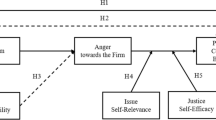Controllers and auditors often encounter corruption in organizations, which involves mutually profitable collusion between the audited agent and the auditing inspector. Due to such corrupt collusion, the audited agents avoid the required inspection of their behavior. To enforce the desired behavior of agents and prevent corruption, a hierarchical inspection structure is organized. In the proposed model we apply the game-theoretical approach to examine the optimal organization of hierarchical structures that enforce honest behavior of both the audited agents and the auditors. Inspections are carried out by honest inspectors, who always perform honest audits, and by so-called rational inspectors, who take bribes when they find it advantageous. The inspection superintendent has information on the proportion of honest inspectors at each level of audit and uses this information to reduce the cost of enforcing honest behavior.
Similar content being viewed by others
References
G. A. Satarov, Anticorruption Policies [in Russian], Fond “Indem”, RA “SPAS”, Moscow (2004).
M. I. Levin and M. L. Tsirik, “Mathematical modeling of corruption,” Ekon. i Matem. Metody, 34, № 4, 34–55 (1998).
P. Chander and L. Wilde, “Corruption in Tax Administration,” J. of Public Econ., 49, № 3, 333–349 (1992).
J. Hindriks, M. Keen, and A. Muthoo, “Corruption, Extortion and Evasion,” J. of Public Econ., 74, № 3, 395–430 (1999).
M. Keren and D. Levhari, “The Internal Organization of the Firm and the Shape of Average Costs,” The Bell Journal of Economics, 14, № 2, 474–486 (1983).
Y. Qian, “Incentives and Loss of Control in an Optimal Hierarchy,” Review of Economic Studies, 61, № 3, 527–544 (1994).
A. A. Vasin, P. A. Kartunova, and A. S. Urazov, “Models of Organization of State Inspection and Anticorruption Measures,” Matem. Modeling, 22, № 4, 67–89 (2010).
A. A. Vasin, Noncooperative Games in Nature and Society [in Russian], MAKS Press, Moscow (2005).
A. A. Vasin, P. V. Nikolaev, and A. S. Urazov, “Corruption Suppression Mechanisms,” Zhurnal Novoi Ekonomicheskoi Assotsiatsii (2011).
A. A. Vain, P. V. Nikolaev, and A. S. Urazov, “Optimal organization of a monitoring structure,” Dokl. RAN, 444, № 3, 262–265 (2012).
D. Fundenberg and J. Tirole, Game Theory, MIT Press, Cambridge MA (1991).
S. N. Chernikov, Linear Inequalities [in Russian], Nauka, Moscow (1968), pp. 136–140.
A. A. Vasin, P. S. Krasnoshchekov, and V. V. Morozov, Operations Research [in Russian], Izd. tsentr “Akademiya”, Moscow (2008), pp. 27–36.
Author information
Authors and Affiliations
Corresponding author
Additional information
Translated from Prikladnaya Matematika i Informatika, No. 42, 2013, pp. 91–111.
Rights and permissions
About this article
Cite this article
Nikolaev, P.V. Corruption Suppression Models: the Role of Inspectors’ Moral Level. Comput Math Model 25, 87–102 (2014). https://doi.org/10.1007/s10598-013-9210-1
Published:
Issue Date:
DOI: https://doi.org/10.1007/s10598-013-9210-1




